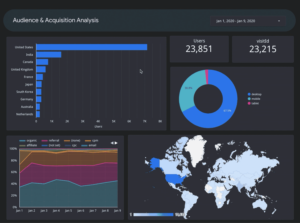What is Google Data Studio: How to Leverage GDS
Maximize Digital Marketing Data Using Google Data Studio
For digital marketers, Google Analytics (GA) offers an illuminating window into customer behavior, interests, and the overall effectiveness of your marketing efforts. That said, for all the powerful insights GA promises, its default user experience leaves a lot to be desired. Like GA, Google Data Studio provides web professionals with robust tools and web analytics. But, what is Google Data Studio? In this article we’ll go over what exactly Data Studio is, and how it can help optimize your website.
One of the most powerful website analytics tools on the market, GA requires some technical knowledge to access its full potential. GA can be programmed to generate custom reports, but they’re difficult to build and limited in their capabilities.
Additionally, business intelligence platforms, like Tableau, are typically managed by IT teams. To fully understand the impact of your marketing and its areas of improvement, self-service access to actionable data is critical.

Enter Google Data Studio, a relatively new resource for analytics. Data Studio integrates with GA to bring the details of digital marketing initiatives to the forefront in reporting, allowing users to track data in GA and utilize Data Studio to transform KPI’s into a visually compelling (and easy to interpret) report for stakeholders at any level.
Get Started in Google Data Studio Today

Use this step-by-step guide to create a dashboard that delivers a simple yet useful view of data that is commonly important to marketers.
Here are three reasons to incorporate Google Data Studio into your digital marketing toolbox.
Google Data Studio Helps Optimize Your Website
No matter how long it’s been since your last redesign, your website remains a work in progress. From SEO performance to content consumption rates, GA holds a wealth of data that allows you to continually optimize your most important marketing tool.
Google Data Studio transforms audience metrics and usage stats into graphics, updated in real-time, on custom dashboards. Custom dashboards enable you to pinpoint areas needing attention on your website and opportunities to improve them. For some industries, Data Studio can even translate website-conversion funnel steps into a visual display. Using graphics that indicate each step of each user’s journey toward becoming a sales lead, you can see the parts of your site that are capturing user interest and where users disengage.
A flexible Content Management System allows you to take those insights and quickly modify your website components or adjust the content, while Data Studio displays the real-time results. Together, they ensure your website is always aligned to meet key business goals.

Data Studio Helps Maximize Marketing Budgets
From sponsored social media posts to display ads, there are many avenues for boosting your brand’s digital profile. To maximize campaign value, it’s critical to understand which efforts are gaining traction. Conversely, responding quickly to campaigns that aren’t delivering positive ROI enables agile teams to repurpose budget toward better-performing initiatives.
No matter which digital channels your organization uses for marketing campaigns, Data Studio can filter the data into a dashboard. Through custom filters, you can establish subsets of data from your site visitors.
Imagine defining a segment of your site traffic from a given period generated by a channel or ad placement. Then, through Data Studio, you can determine the percentage of that traffic that resulted in conversions (e.g., completion of a contact form, making a purchase, etc.).
Whether users visit your site via a social media ad or search results, you can build a dashboard for each lead-gen path. Comparing these users’ performance against your organic site visitors’ habits can enable better content-personalization and -performance for paid campaigns. In the process, you can draw better-informed conclusions about the value of each of your digital marketing channels.
Rather than being forced to invest valuable time collecting and computing data from multiple sources, Data Studio’s functionality provides quick reporting access to the insights needed to maximize your marketing initiatives.
The power of robust, self-service analytics provides marketers with 24/7 SWOT data. Visualizations can point to immediate success: a single dashboard can show a campaign, demonstrate how it raised your brand’s profile, and tally the resulting sales leads. By delivering this information and its ROI clearly, it better supports funding requests for similar initiatives. Visualizations can also show areas where poor digital performance is holding back the business: demonstrated areas where your organization’s website needs UX or structural improvements to convert the leads generated by effective digital marketing campaigns.
In either case, by having real-time, detailed data at your fingertips, you can ensure each dollar in your digital marketing budget generates a positive ROI.

Data Studio Helps Increase Internal Engagement
Even though businesses recognize the future is digital, many marketing teams face an uphill battle for resources. If your organization remains attached to more traditional, in-person sales methods, the visualizations available in Data Studio can still be incredibly useful.
Data Studio’s strength is in its simplicity; reports that once took days to assemble are now on a dashboard and at-the-ready for stakeholder meetings. Instead of relying on a presentation with information that’s already out of date by the meeting time, you can share links to compelling, real-time data.
Data Studio’s flexibility doesn’t just help you secure more financial backing for digital efforts, it encourages more internal engagement as well. After creating targeted dashboards, you can provide links to stakeholders to access data on an as-needed basis. Instead of waiting for static monthly updates, internal teams can utilize the dashboards to improve their real-time understanding of digital marketing efforts (and their positive effect on the bottom line).
Providing your stakeholders with real-time site metrics helps build their understanding of crucial digital marketing contributions, builds capacity and support for the organization to be more digitally-focused in the future, and builds your credibility as a transparent leader focused on positive results.
